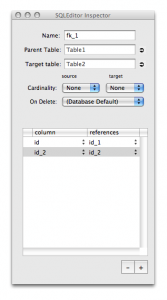So, if you’ve seen SQLEditor recently, you’ll hopefully have seen that there is a new version out: version 1.6. This got released just at the beginning of December 2009
1.6 is something that I’ve been working on now for a long time, it is essentially (the unreleased) version 1.5 with improvements and updates. In particular it contains a SQL parser that was written using ANTLR and a new JNI based system for using JDBC drivers with support for Java 6 JDBC drivers.
It’s also the first release version of SQLEditor that is compatible with Snow Leopard. SQLEditor 1.4.7 and earlier had an unusual architecture. When I originally started writing SQLEditor, it was a Java application with a Swing user interface. After some development it seemed clear that java swing was proving limited in some ways. I rewrote the user interface layer in Cocoa, leaving the model layer in Java and using Cocoa Java to connect the two parts together. The application development continued and new versions were released. Eventually though, Apple decided that Cocoa Java was not the future and decided to deprecate it.
Work began immediately on rewriting the crucial components of SQLEditor, although there were some issues.
The first was the model code. Every object in an SQLEditor document is represented by an object and all of the code for these objects was written in Java. All of the object code was rewritten and tested against the earlier versions to check that it still worked. It was very important that files from previous versions continued to work (and as far as I know all of them so far do). New code was written to read and write the SQLEditor document xml format.
The second major issue was that the database interface used JDBC drivers, which are written in Java. Native code would use ODBC drivers. Although similar this might mean that users wouldn’t be able to use existing arrangements to access databases.
Eventually code was written to bridge between SQLEditor native code and the JDBC drivers using the Java Native Interface (JNI).
The other crucial problem was the SQL parser. This is used if you paste SQL code into SQLEditor or if you import a file. The SQL parser was written using JavaCC, a parser generator that is written in and produces Java code. Several parser generators were looked at to replace JavaCC and eventually ANTLR was chosen.
A new SQL parser was written and tested during 2009 in ANTLR and is included in SQLEditor 1.6. The new parser is completely rewritten compared to the one that existed in SQLEditor 1.4.7 and no code is shared between them.
A major step in developing the new parser was to port all of the SQL test cases from Java (in 1.4.7) to objective C (in 1.6). These automated unit tests are run against the parser to ensure that the new parser behaves correctly compared to both the 1.4.7 parser and the assorted SQL standards.
It is still something of a work in progress though, there are things it doesn’t support and it’s still being actively worked on. One particular thing that makes this somewhat harder than it might otherwise be is that it must accept SQL in several different dialects, not just a single standard.
SQLEditor 1.6 also included user interface improvements and various performance fixes.
Overall it’s an improved program, although I do wish that it had been released sooner.
Thanks to everyone using SQLEditor for your patience and also for trying the beta versions.



